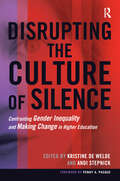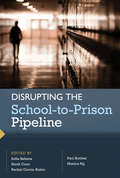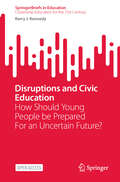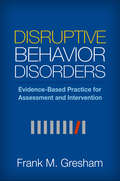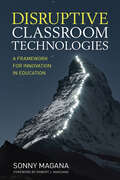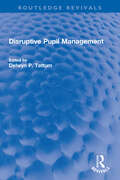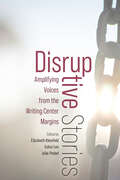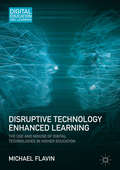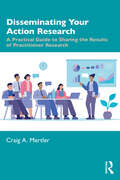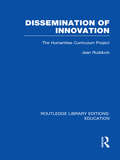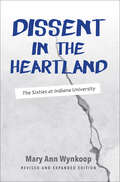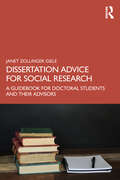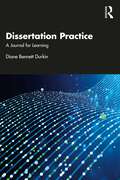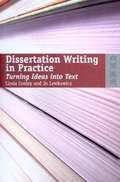- Table View
- List View
Disrupting the Culture of Silence: Confronting Gender Inequality and Making Change in Higher Education
by Andi Stepnick Kristine De WeldeCHOICE 2015 Outstanding Academic TitleWhat do women academics classify as challenging, inequitable, or “hostile” work environments and experiences? How do these vary by women’s race/ethnicity, rank, sexual orientation, or other social locations?How do academic cultures and organizational structures work independently and in tandem to foster or challenge such work climates?What actions can institutions and individuals–independently and collectively–take toward equity in the academy?Despite tremendous progress toward gender equality and equity in institutions of higher education, deep patterns of discrimination against women in the academy persist. From the “chilly climate” to the “old boys’ club,” women academics must navigate structures and cultures that continue to marginalize, penalize, and undermine their success.This book is a “tool kit” for advancing greater gender equality and equity in higher education. It presents the latest research on issues of concern to them, and to anyone interested in a more equitable academy. It documents the challenging, sometimes hostile experiences of women academics through feminist analysis of qualitative and quantitative data, including narratives from women of different races and ethnicities across disciplines, ranks, and university types. The contributors’ research draws upon the experiences of women academics including those with under-examined identities such as lesbian, feminist, married or unmarried, and contingent faculty. And, it offers new perspectives on persistent issues such as family policies, pay and promotion inequalities, and disproportionate service burdens. The editors provide case studies of women who have encountered antagonistic workplaces, and offer action steps, best practices, and more than 100 online resources for individuals navigating similar situations. Beyond women in academe, this book is for their allies and for administrators interested in changing the climates, cultures, and policies that allow gender inequality to exist on their campuses, and to researchers/scholars investigating these phenomena. It aims to disrupt complacency amongst those who claim that things are “better” or “good enough” and to provide readers with strategies and resources to counter barriers created by culture, climate, or institutional structures.
Disrupting the School-to-Prison Pipeline
by Sofía Bahena Paul Kuttner North Cooc Rachel Currie-Rubin Monica NgA trenchant and wide-ranging look at this alarming national trend, Disrupting the School-to-Prison Pipeline is unsparing in its account of the problem while pointing in the direction of meaningful and much-needed reforms. The "school-to-prison pipeline" has received much attention in the education world over the past few years. A fast-growing and disturbing development, it describes a range of circumstances whereby "children are funneled out of public schools and into the juvenile and criminal justice systems." Scholars, educators, parents, students, and organizers across the country have pointed to this shocking trend, insisting that it be identified and understood--and that it be addressed as an urgent matter by the larger community. This new volume from the Harvard Educational Review features essays from scholars, educators, students, and community activists who are working to disrupt, reverse, and redirect the pipeline. Alongside these authors are contributions from the people most affected: youth and adults who have been incarcerated, or whose lives have been shaped by the school-to-prison pipeline. Through stories, essays, and poems, these individuals add to the book's comprehensive portrait of how our education and justice systems function--and how they fail to serve the interests of many young people."
Disrupting the School-to-Prison Pipeline (HER Reprint Series)
by SofÍa BahenaA trenchant and wide-ranging look at this alarming national trend, Disrupting the School-to-Prison Pipeline is unsparing in its account of the problem while pointing in the direction of meaningful and much-needed reforms.The &“school-to-prison pipeline&” has received much attention in the education world over the past few years. A fast-growing and disturbing development, it describes a range of circumstances whereby &“children are funneled out of public schools and into the juvenile and criminal justice systems.&” Scholars, educators, parents, students, and organizers across the country have pointed to this shocking trend, insisting that it be identified and understood—and that it be addressed as an urgent matter by the larger community.This new volume from the Harvard Educational Review features essays from scholars, educators, students, and community activists who are working to disrupt, reverse, and redirect the pipeline. Alongside these authors are contributions from the people most affected: youth and adults who have been incarcerated, or whose lives have been shaped by the school-to-prison pipeline. Through stories, essays, and poems, these individuals add to the book&’s comprehensive portrait of how our education and justice systems function—and how they fail to serve the interests of many young people."
Disrupting the Teacher Opportunity Gap: Aligning 12 Processes for High-Expertise Teaching
by Jon SaphierThe teachers aren’t the problem—it’s the system that needs fixing. The missing element in 70 years of school reform is a surround-sound focus on High-Expertise Teaching. We could have it in any district, regardless of zip code, if we reengineered the twelve processes that impact teachers’ knowledge and skill. A handbook for action and a persuasive case for making every school a reliable engine of constant learning, this book outlines the actions necessary to ensure High-Expertise Teaching reaches more children, more of the time. Informed by a substantial research base and decades of implementation, scholar-practitioner Jon Saphier presents the foundational elements of High-Expertise Teaching in this capstone work, along with A comprehensive plan for effective implementation to scale An assets-based approach to high expectations, culturally responsive teaching, and rigor Templates for re-engineering school- and district-based processes Guidance for leaders on honing their own skills to implement change Excellent teaching is complex and demanding, with challenges beyond what any teacher-preparation program can cover. That’s why we must create a workplace environment that enables and prioritizes continuous professional learning about High-Expertise Teaching.
Disrupting the Teacher Opportunity Gap: Aligning 12 Processes for High-Expertise Teaching
by Jon SaphierThe teachers aren’t the problem—it’s the system that needs fixing. The missing element in 70 years of school reform is a surround-sound focus on High-Expertise Teaching. We could have it in any district, regardless of zip code, if we reengineered the twelve processes that impact teachers’ knowledge and skill. A handbook for action and a persuasive case for making every school a reliable engine of constant learning, this book outlines the actions necessary to ensure High-Expertise Teaching reaches more children, more of the time. Informed by a substantial research base and decades of implementation, scholar-practitioner Jon Saphier presents the foundational elements of High-Expertise Teaching in this capstone work, along with A comprehensive plan for effective implementation to scale An assets-based approach to high expectations, culturally responsive teaching, and rigor Templates for re-engineering school- and district-based processes Guidance for leaders on honing their own skills to implement change Excellent teaching is complex and demanding, with challenges beyond what any teacher-preparation program can cover. That’s why we must create a workplace environment that enables and prioritizes continuous professional learning about High-Expertise Teaching.
Disruptions and Civic Education: How Should Young People be Prepared For an Uncertain Future? (SpringerBriefs in Education)
by Kerry J KennedyThis book examines multiple disruptive processes and the imperative to redesign civic education that will assist young people to cope with uncertainty generated by the intersection of these processes. It identifies multiple and intersecting disruptions influencing young people and the worlds in which they live and indicates how future constructions of education are likely to impact young people and the extent to which they can assist with issues of life uncertainty. Additionally, this book develops a new agenda for future educational values and suggests ways in which civic education can be redeveloped to support young people across political systems facing uncertainties. It serves as a valuable reference for universities globally and their courses in the specific area of civic and citizenship education, as well as comparative education, development education, and international education.
Disruptive Behavior Disorders
by Patrick H. Tolan Bennett L. LeventhalAggressive behavior among children and adolescents has confounded parents and perplexed professionals--especially those tasked with its treatment and prevention--for countless years. As baffling as these behaviors are, however, recent advances in neuroscience focusing on brain development have helped to make increasing sense of their complexity. Focusing on their most prevalent forms, Oppositional Defiant Disorder and Conduct Disorder, Disruptive Behavior Disorders advances the understanding of DBD on a number of significant fronts. Its neurodevelopmental emphasis within an ecological approach offers links between brain structure and function and critical environmental influences and the development of these specific disorders. The book's findings and theories help to differentiate DBD within the contexts of normal development, non-pathological misbehavior, and non-DBD forms of pathology. Throughout these chapters are myriad implications for accurate identification, effective intervention, and future cross-disciplinary study. Key issues covered include: Gene-environment interaction models.Neurobiological processes and brain functions.Callous-unemotional traits and developmental pathways.Relationships between gender and DBD.Multiple pathways of familial transmission. Disruptive Behavior Disorders is a groundbreaking resource for researchers, scientist-practitioners, and graduate students in clinical child and school psychology, psychiatry, educational psychology, prevention science, child mental health care, developmental psychology, and social work.
Disruptive Behavior Disorders
by Frank M. GreshamSchools often resort to ineffective, punitive interventions for the 10% of K-8 students whose challenging behavior interferes with their own and their classmates' learning. This book fills a crucial need by describing ways to provide meaningful supports to students with disruptive behavior disorders. Prominent authority Frank M. Gresham weaves together current research, assessment and intervention guidelines, and illustrative case studies. He reviews a broad range of evidence-based practices and offers recommendations for selecting, implementing, and evaluating them within a multi-tiered framework. Coverage includes school- and home-based approaches, multicomponent programs, prevention strategies, and social skills training.
Disruptive Classroom Technologies: A Framework for Innovation in Education
by Sonny MaganaTimely and powerful, this book offers a new framework to elevate instructional practices with technology and maximize student learning. The T3 Framework helps teachers categorize students’ learning as translational, transformational, or transcendent, sorting through the low-impact applications to reach high-impact usage of technologies. Teachers and leaders will find: Examples of technology use at the translational, transformational, and transcendent levels Activities, guides, and prompts for deeper learning that move technology use to higher levels of the T3 Framework Evaluative rubrics to self-assess current technology use, establish meaningful goals, and track progress towards those goals
Disruptive Classroom Technologies: A Framework for Innovation in Education
by Sonny MaganaTimely and powerful, this book offers a new framework to elevate instructional practices with technology and maximize student learning. The T3 Framework helps teachers categorize students’ learning as translational, transformational, or transcendent, sorting through the low-impact applications to reach high-impact usage of technologies. Teachers and leaders will find: Examples of technology use at the translational, transformational, and transcendent levels Activities, guides, and prompts for deeper learning that move technology use to higher levels of the T3 Framework Evaluative rubrics to self-assess current technology use, establish meaningful goals, and track progress towards those goals
Disruptive Fixation: School Reform and the Pitfalls of Techno-Idealism
by Christo SimsIn New York City in 2009, a new kind of public school opened its doors to its inaugural class of middle schoolers. Conceived by a team of game designers and progressive educational reformers and backed by prominent philanthropic foundations, it promised to reinvent the classroom for the digital age. Ethnographer Christo Sims documented the life of the school from its planning stages to the graduation of its first eighth-grade class. Disruptive Fixation is his account of how this "school for digital kids," heralded as a model of tech-driven educational reform, reverted to a more conventional type of schooling with rote learning, an emphasis on discipline, and traditional hierarchies of authority. Troubling gender and racialized class divisions also emerged.Sims shows how the philanthropic possibilities of new media technologies are repeatedly idealized even though actual interventions routinely fall short of the desired outcomes—often dramatically so. He traces the complex processes by which idealistic tech-reform perennially takes root, unsettles the worlds into which it intervenes, and eventually stabilizes in ways that remake and extend many of the social predicaments reformers hope to fix. Sims offers a nuanced look at the roles that powerful elites, experts, the media, and the intended beneficiaries of reform—in this case, the students and their parents—play in perpetuating the cycle.Disruptive Fixation offers a timely examination of techno-philanthropism and the yearnings and dilemmas it seeks to address, revealing what failed interventions do manage to accomplish—and for whom.
Disruptive Pupil Management (Routledge Revivals)
by Delwyn P. TattumFirst published in 1986, Disruptive Pupil Management presents a comprehensive overview of the disruptive behaviour in schools in the light of the Elton Report. The emphasis of this book is that a preventative approach to the problem is a more valid response than this crisis management approach which results in pupils being sent to special units. The book therefore stresses the importance of schools managing their own techniques and interpersonal skills, rather than schools importing solutions. This book is a must read for all educationists, teachers, and researchers of primary and secondary education.
Disruptive Stories: Amplifying Voices from the Writing Center Margins
by Elizabeth Kleinfeld Sohui Lee Julie PrebelDisruptive Stories uses an activist editing method to select and publish authors that have been marginalized in scholarly conversations and enrich the understanding of lived writing center experiences that have been underrepresented in writing center scholarship. These chapters explore how marginality affects writing centers, the people who work in them, and the scholarship generated from them by examining the consequences—both positive and negative—of marginalization through a mix of narratives and research. Contributors provide unique perspectives ranging across status, role, nationality, race, and ability. While US tenure-track writing center administrators (WCAs) do not make up the majority of those who hold WCA positions in writing centers, they are more likely to be the storytellers of the writing center grand narrative. They publish more, present more conference papers, edit more journals, and participate more in organizational leadership. This collection complicates that narrative by adding marginalized voices and experiences in three thematic categories: structural marginalization, globalization and marginalization, and embodied marginalization. Disruptive Stories spurs further conversations about ways to improve the review process in writing center scholarship so that it more accurately reflects the growing diversity of its administrators and practitioners.
Disruptive Technologies and the Language Classroom: A Complex Systems Theory Approach
by Regine HampelAlthough new technologies are embedded in students’ lives today, there is often an assumption that their use is transparent, inconsequential, or a distraction. This book combines complex systems theory with sociocultural theory and the multimodal theory of communication, providing an innovative theoretical framework to examine how communication and meaning-making in the language classroom have developed over time, how technology impacts on meaning-making, and what the implications are for learners, teachers, institutions and policy makers. Recent studies provide evidence for the disruptive effect of technology which has resulted in a phase shift that is reshaping language education by creating new interaction patterns, allowing for multimodal communication, and introducing real-world communication into the classroom. The book proposes ways of responding to this shift before concluding that the new technologies are radically transforming the way we learn. It is likely to appeal to a range of readers, including students, academics, teachers and policy-makers.
Disruptive Technology Enhanced Learning
by Michael FlavinThis book is about how technologies are used in practice to support learning and teaching in higher education. Despite digitization and e-learning becoming ever-increasingly popular in university teaching settings, this book convincingly argues instead in favour of simple and convenient technologies, thus disrupting traditional patterns of learning, teaching and assessment. Michael Flavin uses Disruptive Innovation theory, Activity Theory and the Community of Practice theory as lenses through which to examine technology enhanced learning. This book will be of great interest to all academics with teaching responsibilities, as it illuminates how technologies are used in practice, and is also highly relevant to postgraduate students and researchers in education and technology enhanced learning. It will be especially valuable to leaders and policy-makers in higher education, as it provides insights to inform decision-making on technology enhanced learning at both an institutional and sectoral level.
Disruptive Women: A WomenEd Guide to Equitable Action in Education
by Vivienne Porritt Lisa Hannay Natasha HiltonDisruptive Women is your guide to changing the status quo in the education system. Drawing from rich, varied perspectives from across the global WomenEd community it offers guidance, solidarity and real-life examples of how to make change happen in four vital areas: Increasing the representation of women in educational leadership Breaking down barriers that exclude diverse women from leadership roles Disrupting the gender pay gap for women leaders Championing flexible working for more equitable working cultures This is unmissable reading for anyone working in schools, universities and other educational organisations who recognises the need to disrupt, innovate and to change education to be more inclusive, equitable and diverse.
Disruptive Women: A WomenEd Guide to Equitable Action in Education
by Vivienne Porritt Lisa Hannay Natasha HiltonDisruptive Women is your guide to changing the status quo in the education system. Drawing from rich, varied perspectives from across the global WomenEd community it offers guidance, solidarity and real-life examples of how to make change happen in four vital areas: Increasing the representation of women in educational leadership Breaking down barriers that exclude diverse women from leadership roles Disrupting the gender pay gap for women leaders Championing flexible working for more equitable working cultures This is unmissable reading for anyone working in schools, universities and other educational organisations who recognises the need to disrupt, innovate and to change education to be more inclusive, equitable and diverse.
Disruptive, Stubborn, Out of Control?: Why kids get confrontational in the classroom, and what to do about it
by Bo Hejlskov ElvénOne of the biggest challenges in the classroom is trying to teach when students act in unexpected and annoying ways. Based on the psychology of how children and people act, this book offers practical strategies for understanding why your students are behaving in the way they are, and how to react in a way that restores peace and harmony in the classroom. With many examples of typical confrontational behaviours and clues for how to understand and resolve the underlying issues, this book will be every stressed teacher's best friend.
Disseminating Your Action Research: A Practical Guide to Sharing the Results of Practitioner Research
by Craig A. MertlerThis practical and easy-to-use book offers professional educators of any academic level, subject area, or position the tools, techniques, and strategies to disseminate, share, publish, and promote the results of their action research projects and studies. Acclaimed author Craig A. Mertler offers a clear-cut guide for practitioner-researchers, covering the following: A robust overview of action research/practitioner research, including its characteristics, processes, and professional benefits; Discussion of the main products for disseminating practitioner research, including written reports, presentations, and visual formats; Delivery strategies for disseminating practitioner research, including refereed publications (both practitioner and scholarly), face-to-face and virtual presentations (conferences, local presentations, and elsewhere), as well as social media and electronic media, from blogs and podcasts to Twitter and LinkedIn. Written for any educational practitioner in any role—from in-service and pre-service teachers in PK-12 or higher education settings to scholars, administrators, policymakers, staff, graduate students, and other researchers—this book offers a pragmatic and motivational guide useful for any field of education in which practitioner research is component.
Dissemination of Innovation: The Humanities Curriculum Project (Routledge Library Editions: Education)
by Jean RudduckThis volume of topical working papers makes available to teachers and to others information intended to stimulate discussion so that all educators may bring their judgement and experience to bear on the concerns of the School Council and contribute to its work. The papers describe plans for curriculum development projects at their formative stages, when comment can be particularly helpful; report on conferences and summarize findings and opinions on debated questions about the curriculum and examination in schools.
Dissent in the Heartland, Revised and Expanded Edition: The Sixties at Indiana University
by Mary Ann WynkoopDuring the 1960s in the heartlands of America—a region of farmland, conservative politics, and traditional family values—students at Indiana University were transformed by their realization that the personal was the political. Taking to the streets, they made their voices heard on issues from local matters, such as dorm curfews and self-governance, to national issues of racism, sexism, and the Vietnam War. In this grassroots view of student activism, Mary Ann Wynkoop documents how students became antiwar protestors, civil rights activists, members of the counterculture, and feminists who shaped a protest movement that changed the heart of Middle America and redefined higher education, politics, and cultural values. Based on research in primary sources, interviews, and FBI files, Dissent in the Heartland reveals the Midwestern pulse of the 1960s beating firmly, far from the elite schools and urban centers of the East and West. This revised edition includes a new introduction and epilogue that document how deeply students were transformed by their time at IU, evidenced by their continued activism and deep impact on the political, civil, and social landscapes of their communities and country.
Dissertation Advice for Social Research: A Guidebook for Doctoral Students and Their Advisors
by Janet Zollinger GieleA guidebook for doctoral students and their advisors, this book provides a map to the many parts of a doctoral thesis – from the statement of the problem, preparation of the proposal, theory, methods, description, and interpretations of findings to the conclusions and implications for future research and practice.Divided into six chapters that cover each step of the dissertation process, Dissertation Advice for Social Research outlines a program for research and writing with examples drawn from doctoral dissertations in sociology, social policy, history, and the humanities. Intended to spark students’ imaginations, each chapter contains examples of dissertations with tips on getting started, drafting and revising the manuscript, and checklists addressed to both students and advisors that spell out actions needed to make progress and to demonstrate a variety of analytic methods – ranging from qualitative interpretations and multivariate analysis of large data sets to historical accounts with examples of various modes of analysis, from grounded theory to qualitative comparisons and statistical tests of significance such as multiple regression.This book is ideal for both doctoral students and their advisors, and will help students get started on their dissertations and to make progress throughout the writing process, regardless of analytic method.
Dissertation Practice: A Journal for Learning
by Diane Bennett DurkinDissertation Practice: A Journal for Learning is an interactive resource that promotes journaling to engender key dissertation practices, through activities and exercises. It is rooted in the view that students can use journaling to promote thought, and that the privacy of journal entries ensures comfort and familiarity. This personal context, along with the book’s open prompts, allows students to engage in extended and alternative thinking.The practices suggested here offer opportunities to imagine, create, explain, rethink, analyze, and argue for a study. The book includes blank space for students to enter short pieces of writing – such as reflections, examples, range of topics, and sample annotations – to generate and review thought, and includes features such as self-assessment questions, working with your chair boxes, revision practices, and examples of students’ work. As a journal of thinking, it allows students to record their thoughts as they materialize into words, provides a safe place for practice and trial, and helps them locate in one place key pieces of writing foundational to their dissertation.This is an essential resource for students in PhD and EdD programs in the social sciences and education who are using qualitative, quantitative, and mixed methods.
Dissertation Research and Writing for Built Environment Students
by Shamil G. NaoumDissertation Research and Writing for Built Environment Students is a step-by-step guide to get students through their final year research project. Trusted and developed over three previous editions, the new fourth edition shows you how to select a dissertation topic, write a proposal, conduct a literature review, select the research approach, gather the data, analyse and present the information and ultimately produce a well-written dissertation. The book simplifies dissertation research and writing into a process involving a sequence of learnable activities and divides the process into three parts. Part One covers the necessary groundwork, including: identifying the problem, writing a proposal and reviewing the literature. Part Two covers the research design and includes: approaches and techniques for data collection and constructing and sampling a questionnaire. Part Three covers: measurement of data, analysis of data with SPSS, structuring and writing the whole dissertation, and supervision and assessment. This new edition is packed with updated examples and research samples, making this the ideal resource for students involved in research in built environment subjects such as construction management, construction project management, facilities management, real estate, building surveying, quantity surveying and civil engineering.
Dissertation Writing in Practice
by Linda Cooley Jo LewkowiczThis book is designed to raise students' awareness of the linguistic features of a postgraduate dissertation/thesis written in English. It deals primarily with the linguistic aspects of extended pieces of writing, placing great emphasis on the writer's responsibility for the readability of the text. Each of the features introduced is illustrated through examples taken from authentic writing at the appropriate level. In addition, each chapter has a number of tasks to help students put into practice the skills that have been introduced. This book is mainly designed to help research students whose first language is not English, but it should also prove useful to native speakers of English, many of whom lack extensive experience of writing at this level. It can be used as a textbook for postgraduate students on a dissertation/thesis writing course, and may also be used as a self-study guide since an annotated answer key is provided for all the tasks. This book takes a realistic approach to helping students who may find the extended writing required at postgraduate level a daunting task; although it provides ample opportunities for practice, it does not expect students to produce extensive writing beyond that required for their degree.
